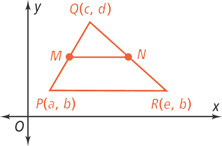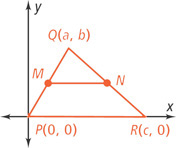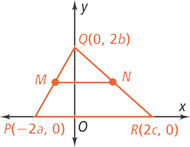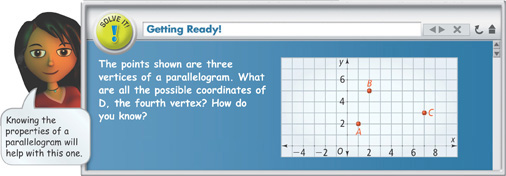6-8 Applying Coordinate Geometry
Objective
To name coordinates of special figures by using their properties
 Lesson Vocabulary
Lesson Vocabulary
- coordinate proof
In the Solve It, you found coordinates of a point and named it using numbers for the x- and y-coordinates. In this lesson, you will learn to use variables for the coordinates.
Essential Understanding You can use variables to name the coordinates of a figure. This allows you to show that relationships are true for a general case.
In Chapter 5, you learned about the segment joining the midpoints of two sides of a triangle. Here are three possible ways to place a triangle and its midsegment.

Figure 1

Figure 2

Figure 3
Figure 1 does not use the axes, so it requires more variables. Figures 2 and 3 have good placement. In Figure 2, the midpoint coordinates are
In Figure 3, the coordinates are M(
Table of Contents
- 6-1 The Polygon Angle-Sum Theorems
- 6-2 Properties of Parallelograms
- 6-3 Proving That a Quadrilateral Is a Parallelogram
- 6-4 Properties of Rhombuses, Rectangles, and Squares
- 6-5 Conditions for Rhombuses, Rectangles, and Squares
- 6-6 Trapezoids and Kites
- 6-7 Polygons in the Coordinate Plane
- 6-8 and 6-9 Coordinate Geometry and Coordinate Proofs





